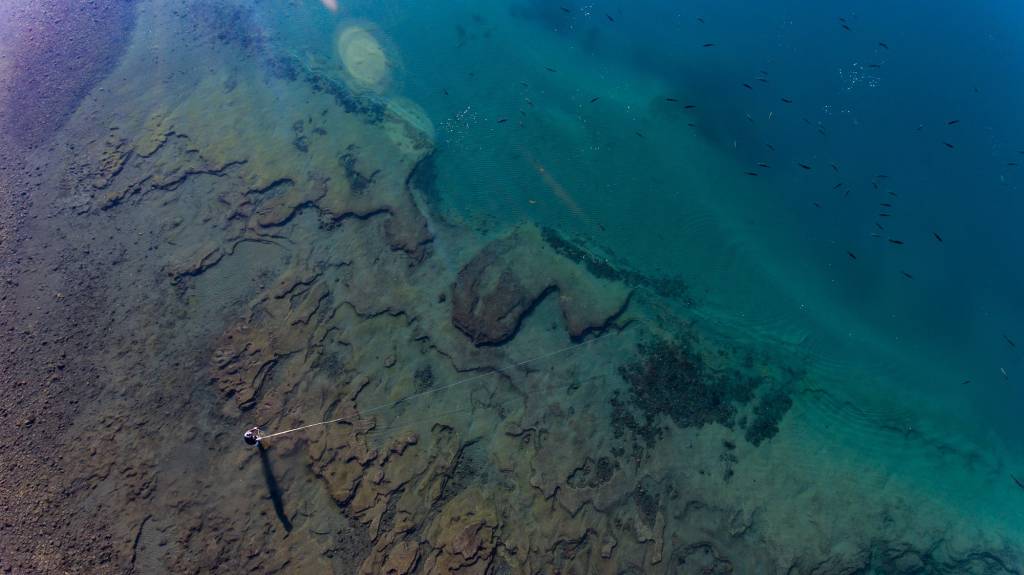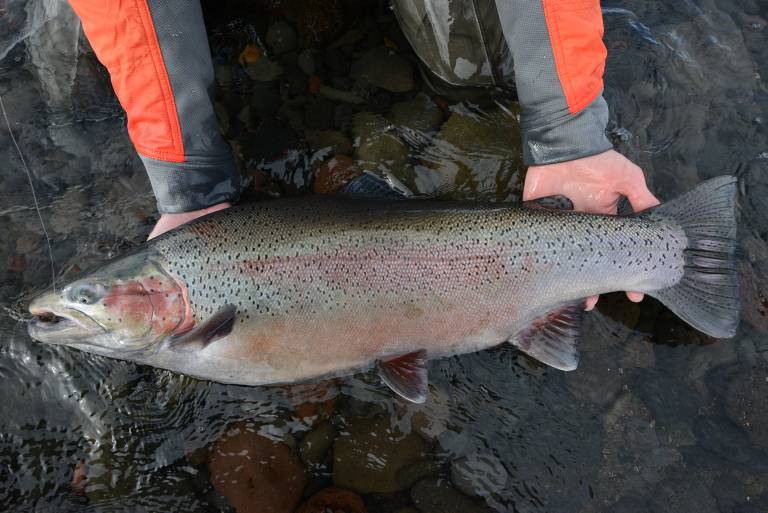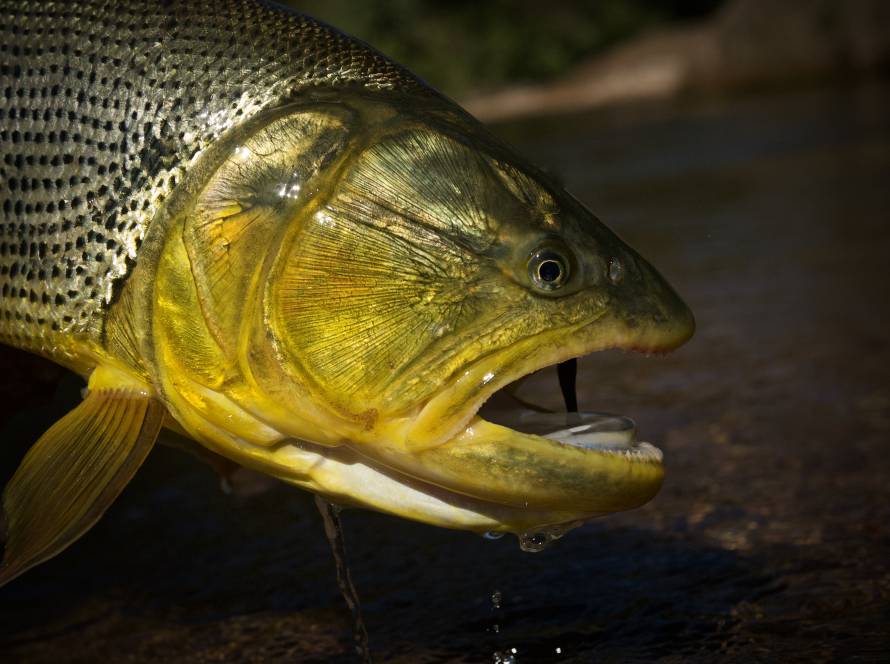Jurassic Lake
You’ve probably heard of Lago Strobel – or Jurassic Lake – as it is most commonly referred to. The lake is world-famous for its massive rainbow trout, but did you know that you can catch these explosive and hard-fighting fish on dry flies?
TEXT: RASMUS OVESEN
PHOTOGRAPHY: RASMUS OVESEN, ANDERS OVESEN AND PEDRO RODRIGUEZ
ANOTHER ONE OF JURASSIC LAKE´S MASSIVE FISH wrenches away from my hands as I carefully remove the barbless streamer from its powerful jaws and release it. It flings cascades of cold water into the air with its iridescent green tail fin as it shoots forward through the water – startled and wilfully headed for the drop off, along which the rest of the school of rainbow trout are foraging.
Having weighed in the vicinity of five solid kilos, the fish was close to the absolutely mental average size on this lake. It is one out of several fish that have remorselessly hit our flies during this April-morning, where the winds have continuously picked up.
My 8-weight is packed away along with the remainder of my gear further down the beach, and with wind gusts starting to reach gale-force levels, I’ve decided that it’s time for the 6-weight to give way for heavier artillery.
I pack away the 6-weight and bow down to pick up my 8-weight. As I grab it, I hear the giggling laughter of the guides somewhere behind me. The cheeky buggers – who have settled momentarily behind their truck for a bit of shelter and a gulp of nourishing, warm Argentinean mate – have tied a large, bright red spoon onto the end of my leader, while I was busy fighting and releasing my last rainbow trout. “Ha, ha, ha! Classic guide humour”, I think to myself! But I pretend as if nothing has happened and just play along.
The laughter falls silent, when – shortly after – I do the unimaginable: I get the spoon airborne, blind cast it for a bit and send it far off into deeper water. The silence doesn’t last for very long, however. Because when a big rainbow trout resolutely hits the spoon and gets hooked, all of us are about to die laughing!

SINCE 2005, when it was first properly discovered, Jurassic Lake in the southern reaches of Patagonia, has stood for me as one of the most monumental fly fishing destinations in the world: A tantalizing and remote fishery in a barren and windswept desert with rainbow trout of near-mythical proportions. And every time I have heard stories about the lake’s spectacular fishing or seen pictures of the almost unrealistically big and shapely fish that are caught there, I’ve felt a relentless pull within. The fact that is has taken me more than 10 years to finally materialise at the lake’s pockmarked shores, therefore shouldn’t be ascribed to a lack of wanderlust or attraction. No, the answer lies, rather, in the seeming paradox of the place: How it has come to embody something unachievable, an impossibility – an unfulfillable promise.
It’s not coincidental that I have a long history of travelling to faraway destinations with a naive and open mind – without having properly adjusted my expectations or done much research. Too often, I have experienced how something that sounded too good to be true, actually was. And, personally, I feel much better being positively surprised than disappointed.
Unfortunately, when it comes to well-exposed fisheries, there’s an increasingly drastic difference between history, reputation and marketing on the one hand and reality (or personal experience) on the other. And as my brother and I land at Lago Strobel – on the rudimentary landing strip recently built by Jurassic Lake Lodge – and we make our way to the lake via windy and uneven gravel roads – the myth is suddenly on an unavoidable collision course with reality.
Everything that I’ve previously heard about this place is now in a wrestling hold with all the sensory impressions my over-stimulated brain is bombarded with – and one simple question begs an answer: Will the fishing be able to match the immense expectations that I’ve managed to build up over the years?
NOW THAT IT’S LATE APRIL – and with the imminence of a relentlessly long and bitterly cold winter, the season is slowly but surely coming to an end, and – according to the guides – the fishing is far from optimal. But, frankly, that suits me just fine!
When, in December and January, the fishing is at its best, it is actually TOO good! This is confirmed by the many stories told by the guides – stories involving vulgar amounts of trout, concentrated along the shoreline in front of Jurassic Lake Lodge where the lake’s only tributary, the Barrancoso River, pours in – and where enduring fly fishermen have caught more than 100 rainbow trout in a single day. (With an average weight of about five kilos that comes to the quasi-industrial catch of half a ton of rainbow trout in less than 24 hours!)
DURING OUR FIRST DAY BY THE LAKE we experience something that few ever experience: A completely windless day, where Lago Strobel’s otherwise frothing surface is like a big, shiny mirror. Bathed in warm light, we move along the beaches and the rocky, lunar-like shores eagerly looking for fish. And it doesn’t take us long before we locate small schools of relatively apathetic and spooky fish swimming about at random. Some nerve-wracking and highly challenging sight-fishing awaits us, and having extended our leaders considerably with cobweb-thin tippets and experimented a bit with flies and presentation, the first few fish nervously start to react.
I’ve sent off a cast in front of few fish circling around near a well-defined drop-off, and as I start retrieving the fly, I immediately capture the interest of one of the fish. It lazily pursues the fly, following its monotonous path through the crystal-clear water with a body-language that, at the same time, seems both tense and indifferent
Shortly after, a vague tug propagates through the fly line, and as I lift the rod, the fish sheds all of its seeming indolence. All hell breaks loose, and I now find myself desperately trying to cushion the effect of a ragingly heavy run, which is only briefly interrupted by hectic scenes of tumultuous headshakes and meter-high jumps. In deeper water – with a full fly line and some 40 metres of backing dragging behind it – the fish finally discontinues its attempted escape and changes tactics. It now tries to find shelter along the lake’s jagged subaqueous tufa-reefs, and all I can do is lift the rod, put maximum pressure on the fish and pray to God that the leader isn’t cut off.
When – a good while later, the fish glides across the frame of my landing net and into the trap of the rubber mesh netting, a loud, cheerful roar is impossible to hold back. My first Jurassic Lake rainbow trout is a reality – and what a fish! It must weigh in the vicinity of six solid kilos, and it is among the most flawless and beautiful fish, I’ve ever seen: Dashingly chrome, with blushing red gills and infinitesimal ink stains along its iridescent green back. And the tail fin! The massive and well-defined tail fin displays a glittering mother-of-pearl glow that radiates from the base, as if all the centrifugal powers from the fish’ fierce tail slaps have made the silvery glow of the flanks exude into the very tips of each tail fin-ray.
AFTER TWO DAYS with some of the best sight-fishing, I’ve ever experienced, the inevitable happens – the winds pick up! It’s as if the weather gods have taken a long, deep breath in order to thoroughly blow the whole desert apart one last time before winter emerges and covers everything in snow and frost.
The howling winds rip and tear at everything that manages to stay erect, and the lake has now re-transformed into its usual self: A roaring ocean, where meter-high waves crash relentlessly onto the shore, partly blown apart by heavy gusts that cause a swirling haze of foam and droplets to rise from the lake. And this is only the beginning…
There isn’t much cover or shelter to be found along the lake, but in the nearby Barrancoso River, which meanderingly transects the desert through towering, narrow canyons, there is an occasional vacuum between the tunnel-like squalls, which makes it possible to sight-cast to both stationary and migratory rainbow trout.
THE BEAUTIFUL BARRANCOSO RIVER is really an unjustified parenthesis in the history of Jurassic Lake. Because even though the river rarely yields fish that rival Jurassic Lake’s monster fish in size, it offers some incredible sight- and close combat-style fishing with plenty of shots at fish in the 3 – 7 kilo range. It is a technically demanding fishery, where stealth skills, precise casts and calm nerves are required, but it’s worth the whole journey in and of itself.
Equipped with light single-handed rods, thin leaders and small streamers, we share many unforgettable moments on the Barrancoso River. But we’re at our most ecstatic, when we manage to land a couple of fish on dry flies and mouse patterns. The experience leaves us craving for more, and for the next couple of days – as the winds die down just a little bit, and the gale force gusts – which have rendered the lake a foaming inferno – run out of breath, we reappear at the lake shores armed with big, buoyant dry flies.
SEING AN 8-KILO TROUT confidently rise through the water column and gulp down a dry fly at close range is indescribably cool! And it happens repeatedly during our last two days at Jurassic Lake. As we’re about to find out, the lake’s chromers aren’t merely interested in scuds, and they always keep an eye upwards – even when the winds are howling and ripping at the water surface.
During the last couple of days – with big and highly visible Chernobyl Ants at the end of our leaders – we land double-digit numbers of rainbow trout between 5 and 9 kilos. And I’m so consumed and devotedly absorbed in the fishing that it isn’t until I sit on the small Twin Otter plane on my way back home via Comodoro Rivadavia that I realize what an extraordinary and unique experience it has been. Here, all the sensory impressions from the past week start to precipitate, and I suddenly become chokingly aware of what an extreme phenomenon Jurassic Lake is. The weather, the terrain, the climate… the fishing. All of it is extreme, and it has left an ineradicable and deep impression in me!
Coming to Jurassic Lake with extremely high expectations, like I have, involves the risk of extreme disappointment. After having experienced the place and the myth, Jurassic Lake, and having experienced a chrome dry fly fishery in a league of its own, there is no doubt left in my mind: This is a place that has not only exceeded my wildest expectations – but also my wildest fantasies!

Fact File: Lago Strobel/Jurassic Lake
Jurassic Lake is the popular name for Lago Strobel: A remote, windswept lake in the Patagonian province of Santa Cruz in Argentina. The lake was inducted into the fly fishing hall of fame when Christer Sjöberg – the founder of Loop Tackle – co-organized an expedition to the lake back in 2005. The expedition stumbled upon a rainbow trout fishery that exceeded most fly fishermen’s wildest fantasies, and once a camp had been established, it didn’t take long before Jurassic Lake – as it was cleverly dubbed – had gained international attention and fame.
Lago Strobel is a 63km2 endorheic basin – i.e. a closed drainage lake without an outlet. It’s set in a treeless lunar-like landscape and its shorelines are strewn with contorted tufa-formations, cliff fragments and even remnants of petrified forest. Lago Strobel is inherently fishless. Why it’s been like that for thousands of years is somewhat of a mystery, but it certainly isn’t due to scarcity of food. The crater-like lake offers a rich base of food mainly consisting of raw amounts of scuds, and with the almost 40 kilometre-long Barrancoso River providing prime spawning- and growth habitat, we’re talking about a unique biotope with an enormous potential.
The explanation as to why the lake has such a prolific population of massive rainbow trout is to be found among the local gauchos – these hardy Argentinean cattlemen, who have found their domain in the windswept and arid terrain surrounding Jurassic Lake. It was the gauchos that introduced a modest number of rainbow trout from the Santa Cruz River into the Barrancoso tributary some 20 years ago – a stock of fish that have flourished in the lake and become a self-reproducing population of monster trout up to 15 kilos (and probably bigger).
Despite its location in the middle of the Santa Cruz desert’s harsh and extremely inhospitable desert plateau, there’s a rich and compelling bird life in- and around the lake. Flamingos, ducks and eagles reside here in addition to the endemic hooded grebe – or maca tobiana, which lives nowhere else in the world, and which wasn’t discovered and documented until some 20 years ago. The lake is also rich in culture and history. People have lived here for more than 9000 years, and along the Barrancoso River you can still find traces of human activity: stone age tools, petroglyphs and settlement remains.
Fact File – Logistics
In order to get to Jurassic Lake Lodge, you need to fly to Comodoro Rivadavia via Buenos Aires. From here, Jurassic Lake Lodge now arranges private charter flights to the lake. This part of the journey, which takes about an hour and a half, replaces and excruciatingly long and bumpy car ride, which – for the last 115 kilometres – from the city of Governor Gregores consists of rudimentary gravel roads that even cross country 4X4’s struggle with. The lodge’s new landing strip was completed in 2015, and there are flights every Saturday and – on demand – Wednesday.
Fact File – Clothes for Jurassic Lake
Jurassic Lake is an extreme and moody place – especially when it comes to the weather. Oftentimes, warm and calm weather is suddenly superseded by cold- and raging winds, and – as a result – you always need to be ready to switch from sunscreen and t-shirts into wool and weather-resistant shell clothing. Late in the season there’s even the risk of snow storms.
Regardless of when you plan to travel to Jurassic Lake, packing several layers of insulating core clothing and wind- and waterproof shell clothing is essential. The winds at Jurassic Lake reach speeds in excess of 100 kilometres an hour, and with the ceaseless imminence of extreme cold (and rain or snow), you’ll want to pack the best clothes out there. In addition to layers and shell-clothing, you should pack a warm wool-Buff, water-resistant gloves, and a beanie (or cap with ear flaps). Together with sunscreen and a pair of UV-protective crewnecks, all these garments should be packed in a waterproof daypack.
There are plenty of sight-fishing opportunities, no matter the wind- and weather conditions. Therefore, a good pair of polaroid sunglasses are essential. They also provide some much-needed protection, when casting in the notoriously tricky winds that rip through the lake basin.
Fact File – The Gear
When it comes to the equipment, you also need to keep the extreme weather conditions in mind – and not least the size of the fish. Generally, 9,6 – 10’ #6-8 fly rods that are capable of handling turbulent winds will be useful, but if you’re lucky enough to experience calm days, you shouldn’t rob yourself of the opportunity to fish a 9’ #4/5 – so bring one just in case. If you’re rather unexperienced when it comes to fishing in heavy winds, you might consider heavy shooting heads – if necessary in combination with switch- or light double-handed rods. Because even though the fish usually patrol the shorelines, sometimes they’ll hang around the drop offs, and then you’ll need long casts to reach them.
The fly reels should have stable, low-inertia brake systems, and they should be able to pack a WF-fly line and 100-150 meters of backing. You’ll mostly be using floating lines, but intermediate lines are great when fishing streamers or nymphs in heavy seas. When doing that, you’ll typically be using fluorocarbon leaders with 0,20 – 0,28mm tippets. Otherwise, when fishing dries, nylon leaders and tippets are to be preferred. Bring along even lighter tippet materials for the odd, windless and sunny day, but never fish lighter tippets than necessary. Remember: Jurassic Lake produces enormous fish, and they are super-powerful!
The flies, that are typically used at Jurassic Lake, are a mix of olive-, white-, grey-, and black streamers ranging in size from 2 – 10, and #8 – 14 nymphs and scud imitations in similar colours – preferably with lively rubber legs. The best dry flies are big and buoyant. Chernobyl Ants and similar foam-dry flies with rubber legs and big, white wings of deer hair work impeccably. At the same time, they’re highly visible when fished at a distance. The common denominator for all of the flies is that they need to be tied on X-strong hooks. Otherwise, the will get straightened out by the bigger fish in the lake.
Fact File – Jurassic Lake Lodge
Jurassic Lake Lodge is a comfortable and atmospheric lodge, which is strategically located precisely where the Barrancoso River enters Lago Strobel. In other words, it is situated in immediate proximity to the lake’s most productive fishing area. Jurassic Lake Lodge accommodates up to 10 fly fishermen, who then have access to several different beats in the lake in addition to 30 kilometres of the incredibly exciting and relatively unexplored Barrancoso River. Furthermore, the lodge owns the rights to the Moro Creek, which is a little river, that connects a series of smaller lakes – and here you can experience some amazing – and practically undiscovered – trout fishing.
For additional information and current prices, please refer to: www.jurassiclakelodge.com or contact lodge-owner, Carlos Lopez Casanello, directly: carlos@jurassiclake.com







